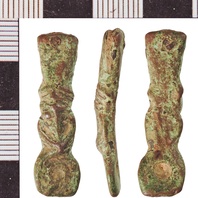
Viking Objects
Zoomorphic Strap-End (NLM-09BBD5)
This cast zoomorphic strap-end has been classified as Thomas Class G and contains decoration consisting of a heart-shaped muzzle, small pellet eyes, and angular grooves which may represent brows. Strap-ends came in various styles and were fairly common throughout the Viking world. They were used to decorate the ends of belts and to stop them getting damaged.
Read More
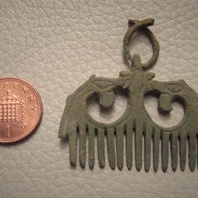
Viking Objects
Comb Pendant (NARC-B3E1B5)
This pendant is unusual for the British isles and has Eastern Scandinavian or Baltic origin. The pendant is decorated with Ringerike-style zoomorphic openwork ornament with a pair of inturning zoomorphic heads. Pendants were a popular dress accessory in Norway and Sweden and sometimes were worn with beads between a pair of oval brooches. In England, pendants did not have the same popularity and there do not seem to be any contemporary Anglo-Saxon pendants.
Read More
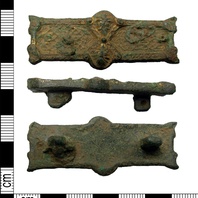
Viking Objects
Gilded Mount (LEIC-127138)
This mount is decorated with rope-like raised decoration, flanked by a plain raised edge. The centre of the mount is decorated with a raised ‘saltaire’ cross. Above and below this cross are semi-circular projections which form the upper part of human face masks which face each other. The remainder of the upper surface is filled with loose ‘chip carved’ interlace. The whole upper surface has patches of gilding, suggesting it originally covered the whole surface. It is possible that it made its way to England prior to Viking incursions but it is equally likely that the Vikings brought this brooch with them as plunder after raiding various areas in Ireland.
Read More
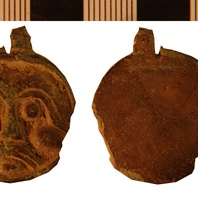
Viking Objects
Copper-Alloy Disc Pendant (NLM-0CA344)
This cast copper-alloy disc pendant has an anthropomorphic design which portrays a facing moustachioed mask. A dark grey coating on front and back may be the degraded remains of a silvered surface. Pendants were a popular dress accessory in Norway and Sweden and sometimes were worn with beads between a pair of oval brooches. For more information on Scandinavian jewellery in England check out our blog: Brooches, Pendants and Pins: Scandinavian Dress Accessories in England.
Read More
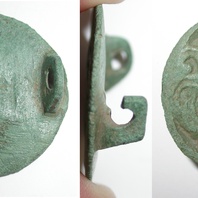
Viking Objects
Borre Style Brooch (DENO-805B20)
This copper-alloy brooch is an example of Kershaw’s East Anglian series and is decorated with interlaced Borre-style designs. For more information on Scandinavian jewellery in England check out our blog: Brooches, Pendants and Pins: Scandinavian Dress Accessories in England.
Read More
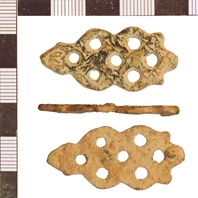
Viking Objects
Anglo-Scandinavian Mount (NLM-491EBD)
This copper-alloy mount is decorated with an openwork plate interlace ornamentation in possible Borre style.
Read More
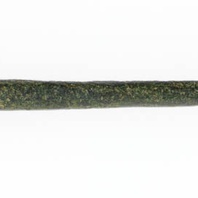
Viking Objects
Needle (CM. 1844-2008)
A cylindrical copper-alloy needle with a circular eye punched into a flattened section. Needles were a common textile tool and could be made from bone, metal or wood. They are generally considered to indicate the presence of female craftspeople, reinforcing the view that the Viking camp at Torksey was inhabited by women and children as well as the warriors of the Great Heathen Army.
Read More
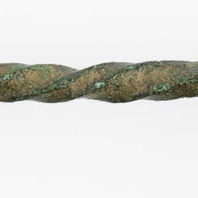
Viking Objects
Copper-Alloy Ear Spoon (CM_1849_2008)
This copper-alloy ear spoon has a spiral twisted body with a small rounded head. It was found at Torksey, Lincolnshire. Ear scoops (also known as ear spoons) were used to clean out ear wax. They are very common finds on Viking Age sites, suggesting that people took this aspect of personal hygiene very seriously.
Read More
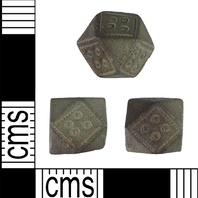
Viking Objects
Polyhedral Weight (LIN-752A9C)
This copper-alloy weight is of a type common within the Scandinavian diaspora. This example has fourteen sides and four dots on each of the rectangular sides. These weights were adopted by the Vikings from Middle Eastern examples and appear to have become a de facto weight standard for traders. Weights are an important form of evidence for Viking Age commerce and the use of standards across the different economic systems within which Vikings were integrated. Many of the weights discovered, particularly ones in Ireland and those of Arabic type, suggest that a standardized system of weights existed in some areas. These standard weights, alongside standard values of silver, are what allowed the bullion economy of Viking occupied areas to function. A bullion economy was a barter economy that relied on the exchange of set amounts of precious metal in various forms, such as arm-rings or coins, for tradable goods, such as food or textiles. Each merchant would have brought their own set of weights and scales to a transaction to make sure that the trade was conducted fairly.
Read More
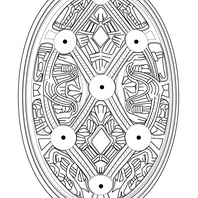
Viking Designs
Drawing of Oval Brooch
Drawing of an oval brooch based on examples for Adwick le Street, Doncaster. Brooches were a typical part of female dress. Scandinavian brooches came in a variety of sizes and shapes which included disc, trefoil, lozenge, equal-armed, and oval shapes. The different brooch types served a variety of functions in Scandinavian female dress with oval brooches typically being used as shoulder clasps for apron-type dresses and the rest being used to secure an outer garment to an inner shift. Anglo-Saxon brooches do not match this diversity of form with large disc brooches being typical of ninth century dress styles with smaller ones becoming more popular in the later ninth and tenth centuries. However, since disc brooches were used by both Anglo-Saxon and Scandinavian women they are distinguished by their morphology. Scandinavian brooches were typically domed with a hollow back while Anglo-Saxon brooches were usually flat. Moreover, Anglo-Saxon brooches were worn singly without accompanying accessories.
Read More
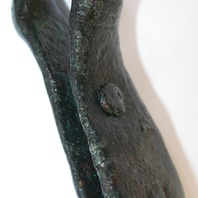
Viking Objects
Suspension Loop (1985/225-1)
This copper-alloy suspension loop was found in Mound 1 at Heath Wood, Ingleby and was probably part of a sword belt. The loop is wide enough for a doubled strap to pass through, so it may have been used to suspend the scabbard from the belt. It has been suggested that this one was probably Anglo-Saxon in origin, because this style is not known from Scandinavia, but that did not stop a Viking acquiring it and being buried with it.
